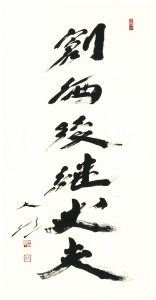Ikeda Sensei sent the following message to the Eighth Soka Gakkai Headquarters Leaders Meeting Toward Our Centennial at the Soka Gakkai Kanagawa Ikeda Auditorium in Yokohama, Japan, on March 6, 2022. This message was originally published in the March 7, 2022, issue of the Soka Gakkai’s daily newspaper, Seikyo Shimbun.
It was here in Kanagawa, a place with which I share a deep connection, that I inscribed the two calligraphic works “Justice” and “Shared Struggle” in May 1979 [immediately after stepping down as third Soka Gakkai president]. Who were the first people I showed them to? It was the youth, my beloved young disciples.
We did gongyo together, our hearts united in prayer, and then I said: “In this time of adversity, I will foster the youth. I will struggle together with the youth. For in a turbulent age, we must place our trust squarely in the power of young people who champion truth and justice. That is the heart of Soka mentors and disciples.”
I still vividly remember those valiant young men and women, their eyes shining with firm commitment.
I wish to wholeheartedly applaud my dear friends of the youth division, champions of justice and shared struggle, on their uplifting leaders meeting today, linked with members around the world and celebrating our great vow to realize kosen-rufu and world peace.[1] Thank you for your tremendous efforts!
My deepest appreciation also to all the members of the Soka family who are chanting for the growth and victory of our young people and always doing everything possible to encourage and support them.
In one of his writings, Nichiren Daishonin relates the story of “The Poor Woman’s Lamp” that appears in the Buddhist scriptures.
Shakyamuni was residing at Jetavana Monastery. Many lamps were lit as offerings to him from the king and by other illustrious and wealthy people. By dawn, however, their lamps had all burned out. Only the single lamp offered by a poor, unknown woman continued burning brightly. It could not be extinguished even by gales like those buffeting Mount Sumeru[2](see “Reply to Onichi-nyo,” The Writings of Nichiren Daishonin, vol. 1, p. 1089).
Why was that? Because, explained Shakyamuni, her lamp was offered with the most pure-hearted sincerity and a lofty vow to illuminate the darkness of all living beings.
I am reminded that the headline emblazoned on the front page of the very first issue of the Seikyo Shimbun read: “Tsurumi’s Torch Burns Bright.” This was referring to none other than the dazzling light of our pioneer members’ lives emanating from Tsurumi here in Yokohama.
More than anyone, our dedicated women of Soka have kept the noble torch of “kosen-rufu through compassionate propagation”[3] burning brightly to this day through their unwavering faith. I am sure that Nichiren, the Buddha of the Latter Day of the Law, would praise them, declaring the torch they carry to be “a lamp of great good fortune” that not even the fiercest winds can extinguish.
And you, our young successors who will go on to become “bluer than the indigo,” are proudly carrying on this torch of “propagation of the great Law”[4] and devoting yourselves to sharing it, heart to heart, with one person after another. That is the practice of respect for others exemplified by Bodhisattva Never Disparaging,[5] the work of sending the inextinguishable light of hope to others.
In this time of crisis, of growing chaos and turmoil, feelings of anxiety about the future, isolation and helplessness weigh especially heavily on young people.
That is why the sincere, courageous voices of Soka youth can revitalize people’s lives, imparting limitless strength, optimism and warmth.
The sincere, courageous voices of Soka youth can revitalize people’s lives, imparting limitless strength, optimism and warmth.
The Daishonin told his young disciple Nanjo Tokimitsu that “the way to become a Buddha … is nothing special. It is the same as … providing fire for a person freezing in the cold” (“The Wealthy Man Sudatta,” WND-1, 1086).
In The Record of the Orally Transmitted Teachings, Nichiren teaches that by chanting Nam-myoho-renge-kyo, we can ignite the fire of the unsurpassed wisdom that “earthly desires are enlightenment” and “the sufferings of birth and death are nirvana” (pp. 10–11). In this way, we can transform all the problems of youth, all the thorny issues facing our societies, into the energy to create new value, just as burning firewood produces heat and light. And we can brightly illuminate the darkness of the sufferings of birth, aging, sickness and death, and open the way for both ourselves and others to embody the noble virtues of eternity, happiness, true self and purity (see OTT, 90).
In his writings, the Daishonin tells us that in an age of conflict, when the people are assaulted by an endless barrage of calamities, “the wonderfully efficacious medicine of the Lotus Sutra [Nam-myoho-renge-kyo] will provide the cure for all these grave disasters” (“Those Initially Aspiring to the Way,” WND-1, 879). The Mystic Law is the great beneficial medicine that can lead all people—equally and without discrimination—to happiness and peace.
The vision of my mentor, Josei Toda, to bring humanity together as one global family was infused with his impassioned wish that no people in any country would be driven into the depths of misery.
People everywhere long to live in happiness and peace. I hope that the greater the challenges, the more you, our young global citizens of Soka, will unite your passion and power. Together, let’s keep reaching out to others in dialogue to create a better world. Let’s strengthen our united prayers to bring peace to our planet—the place we have gathered as Bodhisattvas of the Earth—and actualize the words of the Lotus Sutra “this, my land, remains safe and tranquil” (The Lotus Sutra and Its Opening and Closing Sutras, p. 272).



As March 16, Kosen-rufu Day, approaches, I would like to share again three calligraphic works that I inscribed 40 years ago (in 1982), as I began to scale, together with the youth, the mountain of kosen-rufu in the 21st century.
The first is “Courageous Successors of Soka,” the second is “Eyes Shining With the Joy of Youth” and the third is “Symphony of Life’s Splendor.”
Courageous successors of Soka who have discarded the shallow to seek the profound (see “On the Buddha’s Prophecy,” WND-1, 402), dear friends whose eyes shine with the joy of youth, please unite with your wonderful, like-minded fellow members in 192 countries and territories to spread the dynamic dance of human revolution. I hope that you will work together to make a peaceful symphony of life’s splendor resound in the hearts of the global family of humankind.
References
- The meeting featured a video performance of some 3,000 future and youth division members from Japan and regions around the world singing the Soka Gakkai song “Youth, Scale the Mountain of Kosen-rufu.” The song was interspersed with video clips of members sharing their hopes and determinations. There was also a live flag performance by the music corps and the fife and drum corps. ↩︎
- Mount Sumeru: In ancient Indian cosmology, the mountain that stands at the center of the world. ↩︎
- Part of the inscription on the Soka Gakkai Kosen-rufu Gohonzon: “For the Fulfillment of the Great Vow for Kosen-rufu through the Compassionate Propagation of the Great Law.” ↩︎
- See footnote 3. ↩︎
- Bodhisattva Never Disparaging appears in “Bodhisattva Never Disparaging,” the 20th chapter of the Lotus Sutra. This bodhisattva—Shakyamuni in a previous lifetime—lived at the end of the Middle Day of the Law following the death of the Buddha Awesome Sound King. He would bow to everyone he met and say: “I have profound reverence for you, I would never dare treat you with disparagement or arrogance. Why? Because you will all practice the bodhisattva way and will then be able to attain Buddhahood” (The Lotus Sutra and Its Opening and Closing Sutras, p. 308). However, he was attacked by arrogant monks, nuns, laymen and laywomen, who beat him with sticks and staves and threw stones at him. The sutra explains that this practice became the cause for Bodhisattva Never Disparaging to attain Buddhahood. ↩︎
You are reading {{ meterCount }} of {{ meterMax }} free premium articles

